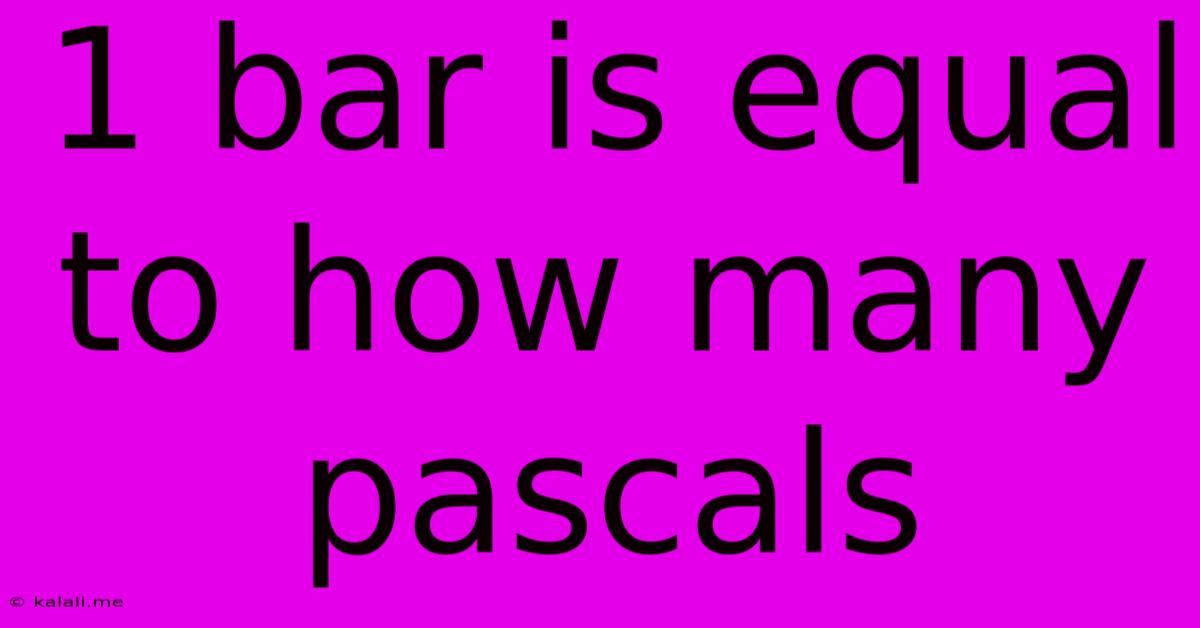1 Bar Is Equal To How Many Pascals
Kalali
Jun 13, 2025 · 3 min read

Table of Contents
1 Bar is Equal to How Many Pascals? A Comprehensive Guide
Understanding pressure units is crucial in various fields, from meteorology and engineering to physics and diving. One common unit of pressure is the bar, often used interchangeably with other units like pascals (Pa). But how exactly do these units relate? This article will delve into the conversion between bars and pascals, explaining the relationship and providing context for understanding pressure measurements.
What is a Bar?
The bar is a unit of pressure defined as exactly 100,000 pascals (Pa). It's a convenient unit because it's close to standard atmospheric pressure at sea level. Historically, it was used extensively in meteorology and other scientific disciplines. While the pascal is the SI unit of pressure, the bar remains widely used due to its convenient magnitude.
What is a Pascal?
The pascal (Pa) is the SI (International System of Units) unit of pressure. One pascal is defined as one newton per square meter (N/m²). It represents the force of one newton acting on an area of one square meter. While technically precise, the pascal is often a very small unit for many practical applications, leading to the prevalence of larger units like the bar, kilopascal (kPa), and even the hectopascal (hPa) in certain contexts.
The Conversion: 1 Bar to Pascals
The conversion is straightforward:
- 1 bar = 100,000 pascals (Pa) or 10<sup>5</sup> Pa
This means that one bar of pressure is equivalent to a force of 100,000 newtons acting on an area of one square meter.
Understanding the Context: Why the Conversion Matters
Understanding the relationship between bars and pascals is important for several reasons:
-
Scientific Accuracy: While the bar might be easier to use in certain situations, using pascals ensures consistency and accuracy when working within the SI system.
-
Data Interpretation: Many scientific instruments and data sets report pressure in pascals. Knowing the conversion allows you to easily interpret these readings regardless of the units used in the original measurement.
-
Engineering Calculations: Accurate pressure conversions are essential for ensuring the safety and reliability of engineering designs, especially in applications involving high pressure.
-
Meteorology: Atmospheric pressure is frequently expressed in hectopascals (hPa), which is 100 pascals. Understanding the relationship between hPa, Pa, and bars is vital for interpreting weather information and forecasts.
Beyond the Basic Conversion: Related Units
While the bar-to-pascal conversion is fundamental, it's also helpful to understand related units:
-
Kilopascals (kPa): 1 kPa = 1000 Pa = 0.01 bar. This unit is frequently used in engineering and industrial applications.
-
Hectopascals (hPa): 1 hPa = 100 Pa = 0.001 bar. Commonly used in meteorology for reporting atmospheric pressure.
-
Millibars (mbar): 1 mbar = 100 Pa = 0.001 bar. An older unit that is still encountered in some contexts.
In conclusion, the conversion of 1 bar to pascals is a simple but crucial relationship to grasp for anyone working with pressure measurements. Remembering that 1 bar = 100,000 Pa will ensure accurate calculations and data interpretation across various disciplines. Understanding the broader context of pressure units and their interrelationships allows for a more comprehensive understanding of pressure phenomena.
Latest Posts
Latest Posts
-
Which Of The Following Is True Of Classical Conditioning
Jun 14, 2025
-
Which Of The Following Is In The Correct Order
Jun 14, 2025
-
Is Density The Same As Mass
Jun 14, 2025
-
Which Trophic Level Has The Most Energy
Jun 14, 2025
-
How Many Milliliters Are In 1 Kiloliter
Jun 14, 2025
Related Post
Thank you for visiting our website which covers about 1 Bar Is Equal To How Many Pascals . We hope the information provided has been useful to you. Feel free to contact us if you have any questions or need further assistance. See you next time and don't miss to bookmark.